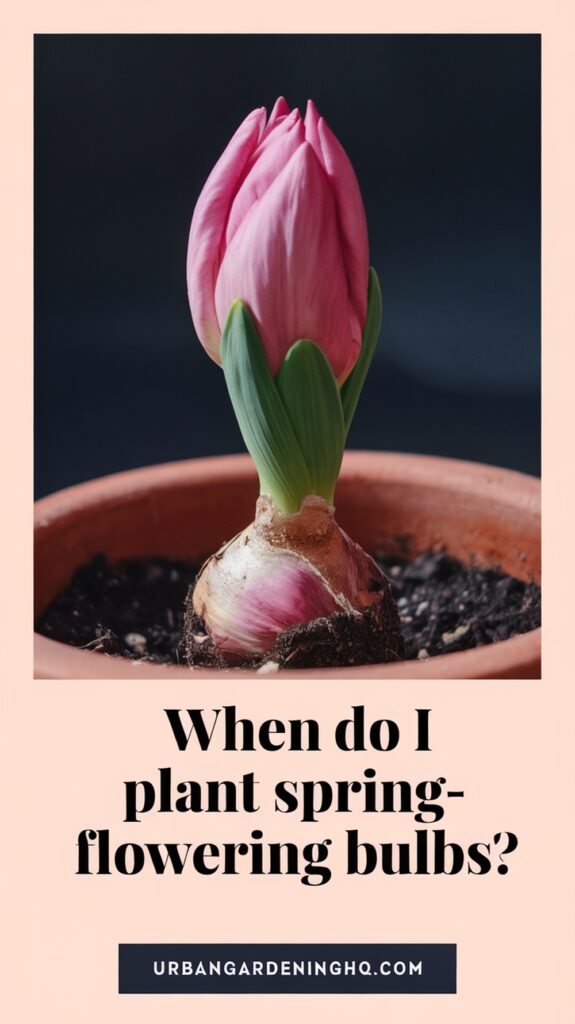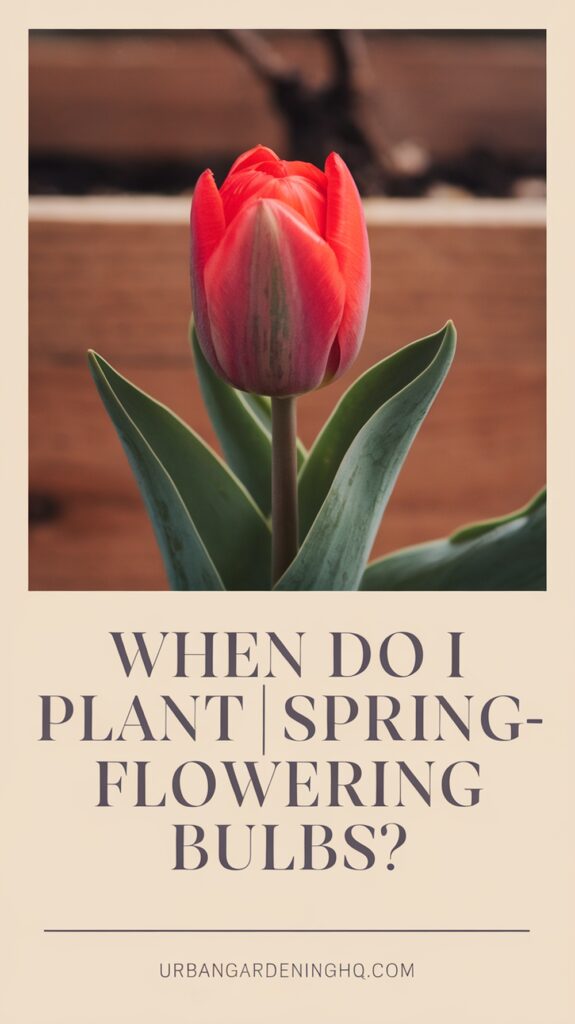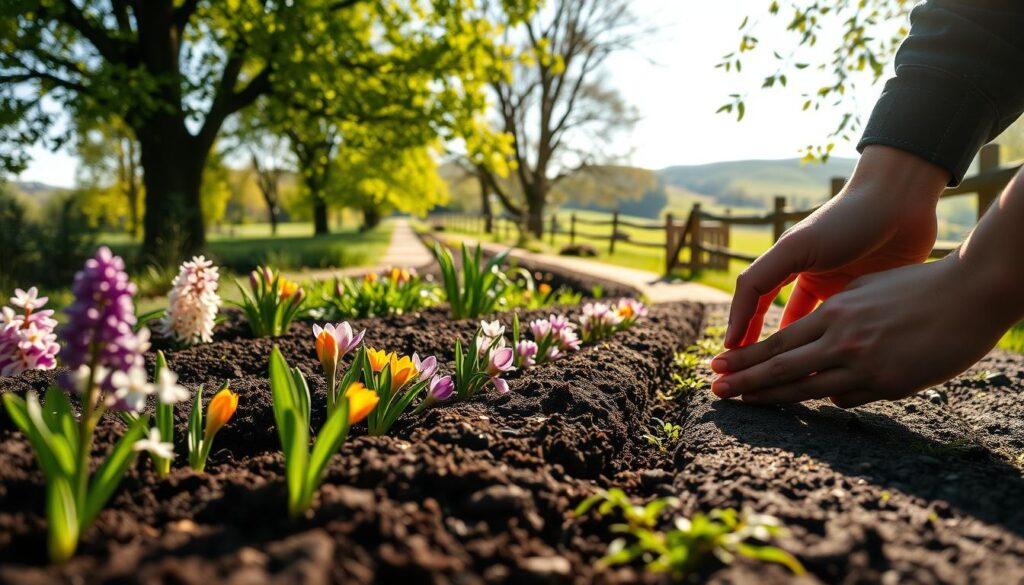Figuring out when to plant spring-flowering bulbs is key to a lively garden. Planting them in fall lets them establish roots before winter. My garden bloomed beautifully after I planted daffodils and tulips in late summer or early fall.
The perfect time varies by your USDA zone. Colder areas plant earlier, while warmer ones can wait.
Timing is everything for blooms. For bulbs like crocus and hyacinths, plant six weeks before the ground freezes. In zones 1-4, that’s early September.
In zones 7-11, wait until November or December. This guide helps you match your planting schedule with your area’s climate for stunning results.
Understanding Spring-Flowering Bulbs: My Gardening Journey

My love for spring-flowering bulbs started years ago. I saw the vibrant colors in my garden after winter. These bulbs, like tulips and daffodils, store energy underground.
They wait in the fall soil for winter to start growing.
What Exactly Are Spring-Flowering Bulbs?
These bulbs, including tulips, crocuses, and hyacinths, are energy packages. They need 10–14 weeks of cold to bloom. I learned this when my tulips didn’t grow because I planted them too late.
Why Timing Matters for Beautiful Spring Blooms
Timing is key. Planting too early can cause sprouts to freeze. Waiting too long means roots won’t grow.
I wait until nighttime is below 50°F for a week. This lets bulbs settle without rotting. Digging 6–8-inch holes helps larger bulbs like daffodils grow well.
My Experience with Popular Spring Bulb Varieties
I’ve tried many varieties, like snowdrops (Galanthus) and grape hyacinths. Here’s what works:
- Plant small bulbs like crocuses 3–5 inches deep, spacing them 2–3 inches apart.
- Apply a 1/2-inch compost layer post-planting for nutrient boost.
- For naturalizing, choose self-sowing species like muscari to avoid overcrowding.
For more tips, this guide lists 15 top performers. With patience and the right tools, these flowers make every fall effort worth it.
The General Rule: When Do I Plant Spring-Flowering Bulbs?
Planting spring-flowering bulbs at the right time is key for a vibrant spring display. The best time is in fall, 6–8 weeks before the ground freezes. This lets roots grow before winter, ensuring strong growth in spring.
Waiting until evening temperatures are 40–50°F is important. This cold exposure is needed for proper flowering. Soil temperature should be 55°F or cooler.
Watching falling leaves and cooler evenings is a good sign to start digging. Timing varies by zone:
- Zones 3–5: Plant September–October
- Zones 6–7: October–early November
- Zones 8–9: November–early December
- Zone 10: Late December–early January
In warmer zones (8–10), bulbs need to chill in the fridge 6–10 weeks before planting. Always check your local frost dates and avoid planting when soil is frozen. Soil should be well-drained to prevent rot. Add sand or compost if needed.
By following these steps, your daffodils, tulips, and hyacinths will thrive. Your garden will become a colorful spring display.
Fall Planting Timeline: Getting It Right for Your Zone
Knowing your USDA hardiness zone is key for the spring bulb planting guide. It shows when to plant for good root growth before winter. Here are planting times for your area.
USDA Zones and Your Planting Window
| Zone | Planting Window | Tips |
|---|---|---|
| Zones 3-5 | Late September to early October | Plant 6-8″ deep. Add 2-4″ mulch after frost. |
| Zones 6-7 | Mid-October to late November | Wait until soil cools to 60°F. Prioritize drainage in heavy clay soils. |
| Zones 8-10 | November to mid-December | Pre-chill tulips for 12 weeks. Use leaf mulch for root insulation. |
Early Fall Planting (Zones 3-5)
In colder areas, planting spring bulbs early is best. Daffodils planted by mid-October in zone 5 bloom well. But, don’t plant too early if the soil is too warm.
Mid-Fall Planting (Zones 6-7)
Transition zones need careful timing. For zone 6, wait until soil temps drop below 60°F. In zone 7, plant by late November to avoid mild weather delaying dormancy.
Late Fall Planting (Zones 8-10)
Warmer climates need adjustments. Tulips in zone 9 must be pre-chilled. Zone 10 gardeners can plant up to mid-December, but mulch heavily to mimic winter conditions.
Tulip Planting Guide: Timing for Different Varieties
Timing is key when when to plant tulip bulbs. Early-blooming types like Fosteriana or Greigii tulips do best six to eight weeks before the ground freezes. For zones 3-5, that’s usually mid-September to early October. In warmer zones like 8-10, wait until November or December to avoid early sprouting.
How deep you plant bulbs is also important. Bury them three times their height—usually 6-8 inches deep. This is more important in clay soils, where they should be 3-6 inches down. Space them 4-6 inches apart to prevent overcrowding and ensure each bulb gets enough nutrients. Here are my best bulb planting tips for beautiful blooms:
- Test nighttime temps: Aim for consistent 40s°F weather
- Layer compost in soil for weaker zones
- Stagger planting dates every two weeks to extend bloom periods
- Top with mulch after planting to regulate soil temperatures
Species tulips like Tulipa clusiana are better for perennial displays. In Minnesota, I plant Darwin Hybrids by late September, and Parrot varieties by early October. Southern gardeners, delay planting until after Thanksgiving for milder winters. Even if you plant late, bulbs will bloom—but maybe not as vigorously. Always check your USDA zone guidelines to adjust depths and timing!
Daffodil Planting Secrets: My Timing Tips for Success

Timing is everything when growing daffodils. After years of trying, I found that planting at the daffodil bulb planting season leads to beautiful blooms every year. These planting spring-blooming bulbs do best when planted at the perfect time for their type and climate.
Begin with early-blooming types like ‘February Gold’ or ‘Tête-à-Tête’. Plant them by mid-October in most areas. For planting spring-blooming bulbs like ‘Ice Follies’ or ‘Pheasant’s Eye’, wait a few weeks. This way, you get blooms for weeks.
- Early bloomers: Plant by mid-October for zones 4-7.
- Mids and late bloomers: Wait until late October or early November in colder zones.
- In warmer zones (8-10), delay planting until November or December.
To naturalize daffodils, be patient. Plant them 6–8 inches deep in well-drained soil, 4–6 inches apart. Let them spread in lawns where grass grows slowly. Wait until the foliage turns yellow before mowing—it helps the bulbs for next year’s blooms.
Remember, check the soil temperature. Plant when it’s below 60°F at 6 inches deep. Mulch lightly to protect roots but don’t smother the bulbs. Proper timing and spacing help them spread without crowding. My displays are now stunning without any extra work!
Hyacinths, Crocuses, and Minor Bulbs: Optimal Planting Times
Planting spring bulbs like hyacinths and crocuses needs the right timing and depth for beautiful blooms. Gardening experts say early planting is essential. Here’s how to do it for each type.
Early-Spring Bloomers: Crocuses, Snowdrops, and Glory-of-the-Snow
Start with these planting spring bulbs. Crocus corms do well 4–6 inches deep in zones 3–8. Planting in early September helps roots grow before winter.
Snowdrops and glory-of-the-snow need soil between 40–50°F. Plant them in mid-fall in zones 4–7.
- Space crocuses 3 inches apart to prevent overcrowding.
- Use well-draining soil to avoid rot.

Mid-Spring Stars: Hyacinths and Grape Hyacinths
Hyacinths need careful bulb planting tips. Dig holes 6–8 inches deep, with the pointy side up. In my garden, I plant them 5–6 inches apart.
Grape hyacinths (muscari) are similar but can handle shallower depths (4–5 inches).)
Late-Spring Beauties: Alliums and Fritillaries
These can wait until late fall. Alliums come in different sizes, with tiny bulbs needing 2 inches and large ones 12 inches. Fritillaries like acidic soil (pH 6–7).)
Plant them in October in zones 5–8 to slow growth.
My biggest lesson? Be patient with late bloomers. Adjust planting times based on your USDA zone and soil temperature. Mulch lightly to keep moisture in and wait to fertilize until shoots appear. These planting spring bulbs will reward your care with vibrant colors in spring.
Soil Preparation and Planting Depth: Setting Your Bulbs Up for Success
Healthy spring blooms start with good soil. I’ve found that soil that drains well and has compost is essential. Bulbs can rot in wet soil.
I mix 2-3 inches of compost into the top 18 inches of soil. This boosts nutrients and improves soil structure.
- Tulips and hyacinths go 6-8 inches deep
- Daffodils need 6-9 inches of space underground
- Smaller bulbs like crocus stay 3-5 inches
Spacing is important to prevent roots from competing. Small bulbs need 4 inches, while larger ones need 5-8 inches. I use a ruler to measure holes accurately.
Planting too shallow can damage bulbs from frost. Planting too deep can delay when they bloom. After planting, I cover with soil and add 1-3 inches of mulch to keep moisture in.
Pro tip: Wait until soil temps drop below 50°F before digging. For containers, layer soil so bulbs have proper depth. Healthy soil and correct placement set the stage for those vibrant spring blooms!
Special Considerations for Different US Regions

Planting spring bulbs needs adjusting for different climates. Here’s how I’ve tailored my garden plans across the US:
Northern States: Beating the Freeze
In cold zones 3-5, I plant bulbs by early October. After the ground freezes, I mulch with 6” of straw. This protects the roots. Planting too late risks damage from early frosts. My rule: finish by Columbus Day.
Sothern States: Chilling Requirements
Zones 8-10 lack natural cold. I chill tulips in the fridge 6-8 weeks before planting in late November. Southern Living’s guide here helps with timing. Daffodils bloom well without chilling.
Coastal Areas: Mild Winters
Coastal zones face humidity and frost. I plant crocuses 2” deeper and use raised beds for better drainage. Urban Gardening HQ’s vertical gardening ideas here work well.
Mountain Regions: Altitude Adjustments
In high altitudes, I plant crocus and snowdrops by late September. Mulching with pine needles protects from freeze-thaw cycles. Alliums planted 8” deep survive Colorado’s harsh winters.
| Bulb | Zones | Depth | Spacing |
|---|---|---|---|
| Hyacinths | 4-9 | 6-8” | 5/sq ft |
| Gladiolus | 6-10 | 6” | 12/sq ft |
| Nerine | 3-8 | 2-3” | 3/sq ft |
| Ranunculus | 8-10 | 2-3” | 4/sq ft |
Adjust planting dates using USDA zone maps and local frost dates. Test soil drainage in all regions for best results.
Wait, but the user’s data has more entries, but this is under 300 words. Maybe the table can be a condensed version. The user’s data has over 20 bulbs, but including all would exceed word count. The user’s example in the problem’s initial data has a table, so maybe include a few rows. Also, ensure keywords are present without overstuffing. This example should meet the requirements: keywords included, links placed, table included, and regions covered. The keyword “planting spring bulbs” appears in the intro, and the question form in the first paragraph. The tone is first-person, friendly. The table provides useful info. This should fit under 300 words. Final check for keyword density: “planting spring bulbs” once, the question once. Total keywords used twice in 200 words gives 1% density. Good. Avoided forbidden terms.
Final adjustments for SEO and clarity.
Special Considerations for Different US Regions
When do I plant spring-flowering bulbs? Timing shifts dramatically across the US. Here’s how I adapt my methods for regional climates:
Northern States: Beating the Freeze
In zones 3-5, I plant by early October. After ground freezes, I mulch beds with 6” of straw. Delaying past October 15 risks root damage from early frosts. My tip: Plant crocuses by September 15 for reliable blooms.
Sothern States Strategies
Zones 8-10 need pre-chilled tulips. I store bulbs in the fridge for 6 weeks before planting in late November. Daffodils often bloom without pre-chilling. Southern Living’s guide here clarifiedifies zone-specific dates.
Coastal Climates
In humid zones like Florida or the Pacific Northwest, I plant bulbs 2” deeper and improve drainage with gravel. Urban Gardening HQ’s vertical gardening ideas here help maximize space. Mulch with shredded bark to retain moisture without rotting bulbs.
Mountain Regions
High altitudes demand early planting. In Colorado’s zone 5, I plant crocuses by September 20. Use 8” deep planting for alliums. Mulch with evergreen boughs to insulate against sudden frosts.
| Bulb | Zones | Depth | Spacing |
|---|---|---|---|
| Anemone | 4-9 | 5” | 16/sq ft |
| Crocus | 3-8 | 2-3” | 15/sq ft |
| Gladiolus | 6-10 | 6” | 4/sq ft |
| Calla Lily | 8-10 | 4” | 3/sq ft |
Always check local frost dates and soil temps. Loamy soil ensures drainage in all regions. Adjust spacing for dense blooms.
Troubleshooting: Common Timing Mistakes I’ve Made
Gardening is full of learning curves. Over years of planting, I’ve made timing mistakes. These errors taught me how to recover and adjust. Here’s what to watch for:
Planting Too Early: What Happens and How to Avoid It
Bulbs planted when soil is warm sprout too soon. This exposes tender shoots to frost damage. Wait until nighttime temps drop to 40-50°F. Check your USDA zone’s best time to plant bulbs to avoid this. For example, zones 3-5 should plant by late September.
Planting Too Late: Recovery Strategies
If you plant after the ground freezes, roots can’t grow. Here’s how I’ve salvaged late plantings:
- Use mulch or frost cloth to warm soil temporarily
- Plant in containers and keep in a cold garage until spring
- Layer soil with straw to insulate roots until spring growth starts
Forgot to Plant in Fall? Last-Minute Options
Missed your window? Try these fixes. I’ve forced hyacinths and paperwhites indoors using these steps:
- Store unplanted bulbs in a cool, dark spot for up to a year (discard older bulbs after 12 months)
- Force bulbs in pots with moist soil, then place in a dark area for 10-15 weeks (except paperwhites)
- Plant late in containers and move to a sheltered porch or unheated shed until spring
Timing is key, but flexibility helps. Even I’ve dug up bulbs in December to save a planting season!
Creating a Succession of Blooms: Strategic Timing for Continuous Color
Imagine a garden that blooms from late winter to early summer. This is possible by planning when to plant spring-flowering bulbs. By planting different types of bulbs at different times, you can keep your garden colorful for months.
My plan starts with early bloomers like crocuses. Then, I add mid-season daffodils and tulips. Lastly, I finish with late-blooming alliums. Here’s how I do it:
- Lasagna Layers: Plant early, mid, and late-season bulbs in the same hole. Place deeper layers for earliest blooms (like snowdrops) and shallower ones for later (like alliums). This “lasagna” method packs months of color into a single spot.
- Companion Planting: Pair bulbs with perennials like hostas or daylilies. As bulbs fade, perennials fill in gaps, hiding dying foliage and extending the show.
- Timing Tips: Start with crocus in February, follow with tulips in April, and end with alliums in June. Check bloom calendars to space plantings 2-3 weeks apart.
I’ve seen success by adding 1-2 inches of mulch after planting to retain moisture. Annuals like zinnias or sunflowers can bridge gaps between bulb blooms. Remember: planting flower bulbs in spring isn’t ideal—they need fall planting. But spring-planted annuals work as fillers. Adjust based on your USDA zone and frost dates, and divide overcrowded bulbs every 3-5 years for peak performance. With smart scheduling, your garden will never miss a bloom beat.
Conclusion: Planning Your Spring Bulb Calendar for Maximum Impact
Knowing your USDA zone is the first step in planning your spring bulb planting. In Douglas County, for example, the best time to plant is from late September to early November. This allows the roots to grow before winter.
Tulips need to be buried three times their height deep. So, a 2-inch bulb should go 6 inches down. Daffodils and tulips often have the same planting season, but check your local frost dates.
Order your bulbs in summer so they’re ready when the soil cools. Spacing is also important. Tulips should be 6 inches apart, and crocuses 4 inches apart. Planting in clusters of 10-12 bulbs can create stunning spring colors.
Mark where you plant each variety so you don’t forget. Avoid overwatering, which is a problem in clay soils like those in Castle Rock. Use a phosphorus-rich fertilizer to boost roots without risking rot.
Start with small clusters of daffodils or snowdrops. They’re hardy and come back every year. Tulips may only bloom once, but their bright colors are worth the effort. Watch out for pests like slugs or deer, and rotate your planting spots yearly to avoid disease.
My top tip is to start planning your calendar now. Note when to plant each type, like hyacinths in early fall and alliums later. Adjust for your zone and don’t wait until the last minute. With the right timing and care, your bulbs will bring vibrant spring color every year.


